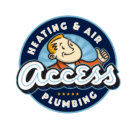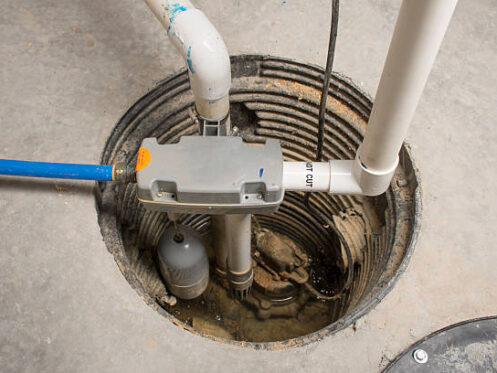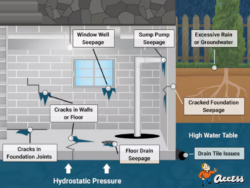Here in the Treasure Valley, we’re fortunate to enjoy stunning landscapes, vibrant seasons, and a tight-knit community. But as any longtime homeowner knows, our region’s weather can be unpredictable—especially when it comes to water. Heavy spring rains, rapid snowmelt from the Boise Foothills, and sudden summer storms can overwhelm drainage systems, leaving basements and crawl spaces vulnerable to flooding.
At Access Heating, Air & Plumbing, we’ve been helping Boise and Treasure Valley homeowners protect their properties for over 50 years. One of the most effective and often overlooked solutions for preventing water damage is a sump pump. In this comprehensive guide, we’ll cover:
-
What a sump pump is and how it works
-
Why sump pumps are critical in the Treasure Valley
-
The dangers of not having one
-
How they protect your home’s foundation, air quality, and value
-
Signs you may need a sump pump (or an upgrade)
-
Maintenance tips to keep your system running smoothly
Whether you’re a new homeowner or have lived here for decades, understanding sump pumps could save you thousands in repairs. Let’s dive in!
What Is a Sump Pump?
A sump pump is a small but powerful device installed in a pit (called a sump basin) in your basement or crawlspace. Its sole purpose is to collect and redirect water away from your home’s foundation before it can seep into your living space.
How Does It Work?
-
Water collects in the basin – As groundwater rises or rainwater seeps in, it flows into the sump pit.
-
The pump activates automatically – Most sump pumps use a float switch (similar to a toilet tank) that triggers the pump when water reaches a certain level.
-
Water is pumped outside – The pump ejects water through a discharge pipe, directing it safely away from your home’s foundation.
Types of Sump Pumps
There are two main types of sump pumps, each with its own advantages:
-
Submersible Sump Pumps
-
Fully submerged in the basin, making them quieter.
-
More efficient and longer-lasting.
-
Ideal for homes with frequent water issues.
-
-
Pedestal Sump Pumps
-
The motor sits above the basin, keeping it dry.
-
Easier to service but noisier.
-
Best for smaller pits or less severe flooding.
-
For maximum protection, we recommend a battery backup system or water-powered backup pump. Idaho’s storms can knock out power at the worst possible time—having a backup ensures your basement stays dry even during an outage.
Why Sump Pumps Are a Must in the Treasure Valley
Our region’s unique geography and weather patterns make sump pumps essential for many homes. Here’s why:
1. Clay Soil & Poor Drainage
The Treasure Valley has dense, clay-rich soil, which absorbs water slowly. Instead of draining away, rainwater and snowmelt pool around foundations, increasing the risk of leaks and flooding.
2. Rapid Snowmelt & Spring Rains
Winters in Boise bring snow, and when temperatures rise suddenly (as they often do in March and April), that snow melts quickly. Combined with spring downpours, this can overwhelm drainage systems.
3. High Water Tables in Some Areas
Homes near the Boise River, canals, or in low-lying neighborhoods often have high groundwater levels. This means water is constantly pressing against basement walls, increasing the risk of seepage.
4. Basement Finishes & Valuables at Risk
Many Treasure Valley homeowners use basements as living spaces, home gyms, or storage. A single flood can ruin drywall, flooring, furniture, and irreplaceable belongings.
The Hidden Dangers of Not Having a Sump Pump
Ignoring basement moisture can lead to expensive, long-term problems, including:
1. Costly Flood Damage
Just 1 inch of water can cause $10,000+ in damage—ruining carpets, drywall, and personal items. Many insurance policies don’t cover flood-related claims unless you have specific flood insurance.
2. Mold & Mildew Growth
Damp basements create the perfect environment for mold, which can spread quickly and harm indoor air quality. Mold remediation is expensive and can aggravate allergies and asthma.
3. Foundation Cracks & Structural Damage
When water pools around your foundation, it creates hydrostatic pressure, which can lead to:
-
Cracks in walls and floors
-
Bowing basement walls
-
Uneven settling of the home
Repairing foundation issues can cost tens of thousands of dollars—far more than installing a sump pump.
4. Higher Insurance Premiums
Frequent water damage claims can increase your premiums, and some insurers may even deny coverage if you don’t have proper flood prevention measures.
How a Sump Pump Protects Your Home (Beyond Just Keeping It Dry)
A well-maintained sump pump does more than just move water—it preserves your home’s integrity and comfort. Here’s how:
✅ Prevents Costly Flooding
-
Automatically removes water before it reaches your floors.
-
Reduces the risk of ruined belongings and structural damage.
✅ Improves Indoor Air Quality
-
Reduces humidity, preventing musty odors and mold growth.
-
Helps maintain a healthier living environment.
✅ Protects Appliances & Utilities
-
Keeps water away from furnaces, water heaters, and electrical panels.
-
Prevents corrosion and malfunctions in essential home systems.
✅ Maintains Your Home’s Value
-
A dry basement is a major selling point for potential buyers.
-
Prevents long-term damage that could decrease resale value.
Is It Time for a Sump Pump in Your Home?
You may need a sump pump if:
✔ Your basement has flooded before (even just once).
✔ You notice damp spots, peeling paint, or efflorescence (white, chalky mineral deposits) on walls.
✔ Water pools near your foundation after rain.
✔ Your current pump is over 10 years old or showing signs of failure (e.g., loud noises, constant running, rust).
Already Have a Sump Pump? Keep It Running Smoothly With These Tips:
🔹 Test it regularly – Pour water into the pit to ensure it activates.
🔹 Clean the basin – Remove debris that could clog the pump.
🔹 Check the discharge line – Make sure it directs water at least 10 feet away from your foundation.
🔹 Consider a backup system – Power outages happen—don’t get caught unprepared!
Why Choose Access Heating, Air & Plumbing for Your Sump Pump Needs?
Since 1972, we’ve been the Treasure Valley’s trusted name for HVAC, plumbing, and sump pump solutions. Here’s what sets us apart:
✔ Expert Assessment – We’ll evaluate your home’s drainage needs and recommend the best system.
✔ Quality Installations – We use durable, high-performance pumps with backup options.
✔ Honest, Upfront Pricing – No hidden fees—just reliable service.
✔ Maintenance Plans – Keep your system in top shape with our annual inspections.
Don’t Wait for Disaster—Protect Your Home Today!
Your home is your biggest investment—don’t let water damage ruin it. With a properly installed sump pump, you can enjoy peace of mind, no matter what the Idaho weather brings! 🌧️🏠💧


